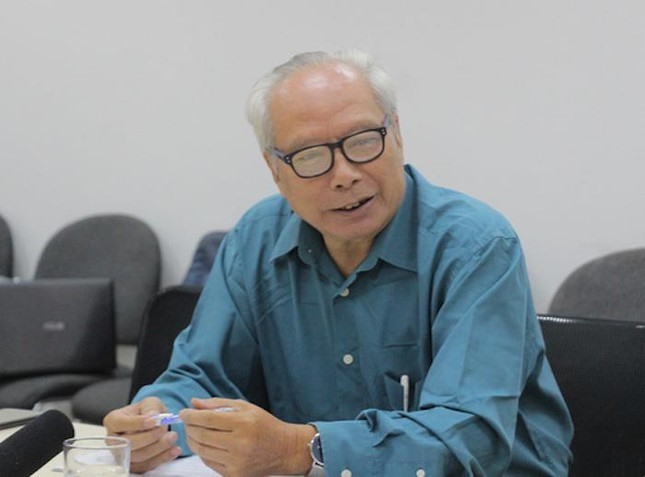problems with the structure of many universities
According to the 2018 Law on Higher Education, universities and colleges are two different concepts. Universities are training institutions for many majors but do not train many fields. While universities will train in many fields, each field has many majors. Therefore, universities will include universities.
Currently, the country has 10 universities, including 5 national and regional universities.
Dr. Le Viet Khuyen - Vice President of the Association of Vietnamese Universities and Colleges - said that before 1993, there were no multi-disciplinary universities in Vietnam.

All higher education institutions, to serve the human resource needs of an economy under a centralized planning mechanism, are built according to the model of the former Soviet Union, that is, all specialized universities.
What is called the General University is actually just a school for basic science training, said Mr. Khuyen.
Analyzing further the university model in universities, Mr. Khuyen said that to implement Resolution TW4 (Core 7), the State has a policy of building multi-disciplinary universities and in 1993 and 1994, 5 multi-disciplinary universities, Hanoi National University, Ho Chi Minh City National University, Thai Nguyen University, Hue University and Da Nang University, were established, based on the principle of gathering a number of specialized higher education institutions in the same area.
As originally proposed from the Project on planning a network of higher education institutions submitted by the Ministry of Education and Training to the Council of Ministers (ie the Government) since 1992, all multi-disciplinary universities must be organized as a single body, especially in the field of training, with a 3-level governance system: university (University), school (college) and department (Department), that is, according to the model of American universities.
However, the implementation process, for many reasons, the structure of 3 levels of schools - faculties - faculties (the governance style of the former Soviet Union) is basically kept the same in member schools. Meanwhile, at multi-disciplinary universities, there is a structure of 4 levels: university - school - department - department.
To maintain its position as an independent university, member schools when translating the structure of the four levels above to English often use the model: University - University - Faculty - Department, causing misunderstanding among foreign colleagues that multi-disciplinary universities in Vietnam are university corporations - Dr. Le Viet Khuyen analyzed.
Meanwhile, according to Mr. Khuyen, multi-disciplinary universities must be organized as a single body, especially in the field of training, with a 3-level governance system: university (University), college and department (Department). The school is located in a university, completely not considered an independent university.
However, the 2012 Law on Higher Education calls multi-disciplinary universities the two-level university model (University in University), or the mother-child university model. In fact, this is a model of a consortium of specialized universities with 4 levels of management: University - university - department - subject. And the World Bank experts themselves said that this model is unique in any country.
Lack of the combined strength of a multi-disciplinary university
Mr. Khuyen acknowledged that the gathering of a number of specialized higher education institutions into universities aims to promote the strength of member units, sharing intelligence and brainpower. But clearly, this was not effective.
Member schools in multi-disciplinary universities have high autonomy, so they operate almost independently, without coordination with each other, first of all in terms of training. Therefore, it cannot demonstrate its comprehensive strength as true multi-disciplinary universities.
In addition, the system of documents and regulations still has some shortcomings: Universities are not considered a unified whole, the University Council is not in accordance with the spirit of university autonomy (which only shows the spirit of decentralization); Member schools recognized by the state have the status of almost an independent university, which effectively nullifies the university level, losing the inherent combined strength of a multi-disciplinary university.
The above problems are also the cause of the phenomenon of separation. In the past, many member schools have demanded to be separated from regional universities. In addition, there is also the need to raise universities or link universities to "unasterities below the standards" without reorganization" - Dr. Le Viet Khuyen analyzed.
Mr. Bui Xuan Hai - Principal of Hai Phong University:
Currently, there is almost no model of two-level universities in the world, meaning there are no "colleges in universities".
In Vietnam, in 1995-1996, the national university model was born. Some units have admitted many member schools and established many faculties. In recent years, these faculties have become member schools. There are small member schools, with a scale of only about 100 teachers and a few thousand students.
This makes it impossible for member schools to develop, and at the same time fall into the situation of "one side, two sides", both under the management of universities and state management agencies. This is contrary to the principle of university autonomy.
Mr. Vu Hoang Linh - Chairman of the Council of the University of Natural Sciences, Vietnam National University, Hanoi:
The 2-level university model is facing many problems and needs to be reviewed. From the perspective of a professional, Mr. Linh said that the most difficult thing for the university model is not management, but when working with foreign partners.










